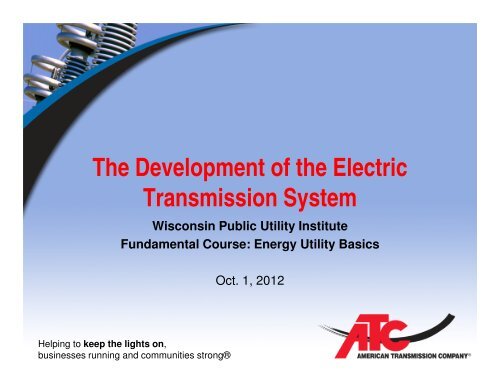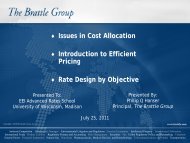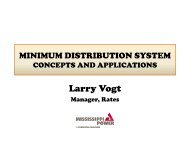History and Future of Transmission, ATC - Wisconsin Public Utility ...
History and Future of Transmission, ATC - Wisconsin Public Utility ...
History and Future of Transmission, ATC - Wisconsin Public Utility ...
- No tags were found...
Create successful ePaper yourself
Turn your PDF publications into a flip-book with our unique Google optimized e-Paper software.
The Link BetweenResources <strong>and</strong> Customers (cont.)www.atcllc.com3
Historical <strong>Transmission</strong>Development• Prior to the late 1970s high-voltagetransmission was planned, constructed,operated <strong>and</strong> owned by utilities to connecttheir generation to their customers• <strong>Transmission</strong> was developed largely byinvestor-owned utilities (IOUs), with some bycooperatives, municipal utilities <strong>and</strong> federalpower agencies• Use <strong>of</strong> <strong>and</strong> interconnection to transmissionfacilities was at the discretion <strong>of</strong> the ownerwww.atcllc.com4
Energy Policy Act <strong>of</strong> 1992• EPAct 92 followed debates in the late 1980sabout open access• FERC was granted the authority to order atransmission owner to provide access toExempt Wholesale Generators• If transmission service was denied, theapplicant could make a request to FERC• <strong>Transmission</strong> Dependent Utilities used thisapproach to purchase power competitivelywww.atcllc.com6
Order No. 888• FERC in this 1996 order established thepro forma Open Access <strong>Transmission</strong> Tariff(OATT)– Contains minimum terms <strong>and</strong> conditions fortransmission service– Required transmission owners to also takeservice under the OATT• Encouraged participation in IndependentSystem Operators (ISOs)www.atcllc.com7
Order No. 2000• FERC in the 1999 order encouraged formation<strong>of</strong> Regional <strong>Transmission</strong> Organizations (RTOs)– Membership is voluntary– Jurisdictional utilities required to file a plan to join anRTO or explain why they were not• Order established characteristics <strong>and</strong> functionsthat an RTO must satisfy– Characteristics include independence– Functions include tariff design <strong>and</strong> administration,OASIS administration, <strong>and</strong> transmission planningwww.atcllc.com9
ISOs <strong>and</strong> RTOsSource: FERCwww.atcllc.com10
Formation <strong>of</strong> MISOSource: MISOwww.atcllc.com11
Order No. 890• FERC in this 2007 order sought to remedyopportunities for undue discrimination <strong>and</strong>address deficiencies in the pro forma OATTthat were apparent since Order Nos. 888 <strong>and</strong>889• These reforms sought to increasetransparency in the rules applicable toplanning <strong>and</strong> use <strong>of</strong> the transmission systemwww.atcllc.com12
Order No. 890 (cont.)• Notably, FERC required regional <strong>and</strong> localplanning processes to be established in OATTsthat met nine principles:– Coordination– Openness– Transparency– Information exchange– Comparability– Dispute resolution– Regional coordination– Economic planning studies– Cost allocation for new projectswww.atcllc.com13
Order No. 890 Planning RegionsSource: FERCwww.atcllc.com14
Federal Laws Focus onIdentifying <strong>Transmission</strong> Needs• Energy Policy Act <strong>of</strong> 2005 directed theDepartment <strong>of</strong> Energy to produce a report ontransmission system congestion every threeyears <strong>and</strong> to identify National InterestElectric <strong>Transmission</strong> Corridors• American Recovery <strong>and</strong> Reinvestment Act in2009 provided funding to DOE to supportinterconnection-based transmission planningstudies by industry <strong>and</strong> stateswww.atcllc.com15
Who Builds <strong>Transmission</strong>• The types <strong>of</strong> companies that buildtransmission include:– Vertically integrated transmission owners(including IOUs, coops, munis)– St<strong>and</strong>-alone transmission companies– Partnerships between utilities– Merchant transmission developerswww.atcllc.com16
<strong>ATC</strong> – A St<strong>and</strong>-Alone<strong>Transmission</strong> Companywww.atcllc.com• <strong>ATC</strong> owns, operates, plans, builds <strong>and</strong> maintainsthe high-voltage transmission system in portions<strong>of</strong> WI, MI, MN <strong>and</strong> IL17
<strong>ATC</strong>’s Formation• Before <strong>ATC</strong>, the transmission system in ourfootprint was aging/inadequate <strong>and</strong> there wasinsufficient access to developing energy markets• <strong>ATC</strong> started business 1/1/01 as the first multistate,transmission-only utility in the U.S.• Companies that transferred transmission assetsor cash to <strong>ATC</strong> are now equity owners– Owned by 29 IOUs, municipalities, municipal utilities<strong>and</strong> cooperatives• Regulated by FERC for rates <strong>and</strong> by statecommissions for construction <strong>and</strong> sitingwww.atcllc.com18
D<strong>ATC</strong> – The Partnership <strong>of</strong><strong>ATC</strong> <strong>and</strong> Duke Energy• Duke – American <strong>Transmission</strong> Company(D<strong>ATC</strong>) is a 50/50 joint venture, formed in 2011to develop transmission on a national scale• Founded on a vision <strong>of</strong> transmission as theenabler <strong>of</strong> efficient generation markets• Committed to developing projects that deliver astrong portfolio <strong>of</strong> reliability, economic <strong>and</strong>public policy benefits• <strong>Transmission</strong> projects will be owned by D<strong>ATC</strong>or subsidiaries with services provided by <strong>ATC</strong>,Duke <strong>and</strong>/or third partieswww.atcllc.com19
D<strong>ATC</strong> Midwest Portfolio• Seven phases across fivestates• 1,200 circuit miles <strong>of</strong>345kV lines <strong>and</strong> 550 miles<strong>of</strong> 500kV high-voltagedirect-current lines• Estimated capital cost <strong>of</strong>~$4 billion• Received conditionalFERC rate approval inJune 2012• Being considered in MISOplanning processwww.atcllc.com20
D<strong>ATC</strong> Zephyr Merchant<strong>Transmission</strong> Project• Transmit renewableenergy to California <strong>and</strong>Southwest• FERC granted Zephyrnegotiated rate authority• Anchor Shipper – 70%<strong>of</strong> capacity contracted• ±500 kV HVDCtransmission line• ~725-950 miles• Estimated capital cost~$3.5 billion• Target in-service date:early 2020www.atcllc.com21
Order No. 1000Source: The Energy Daily• Issued on 7/21/11• Timing <strong>of</strong> reformsdriven by the amount<strong>of</strong> transmissioninvestment expected• At least 60 requests forclarification/rehearingfiled with FERCwww.atcllc.com22
Major Areas <strong>of</strong> Reform• Order No. 1000 advances requirements infour major areas:– Participation in a regional transmission planningprocess that produces a regional plan <strong>and</strong>considers needs driven by public policy– Improvements in inter-regional planning– Removes federal right <strong>of</strong> first refusal (ROFR) forincumbent transmission owners to build projects,opening up certain projects to competition– Principle-based regional <strong>and</strong> inter-regional costallocation methodologieswww.atcllc.com23
FERC Issues Order No. 1000-A,Challenges to Rulings PersistSource: SNL• FERC on 5/17/12 affirmed initial order,namely the ROFR requirements– At least six parties thus far have filed a requestfor clarification/rehearing <strong>of</strong> Order No. 1000-A• At least 14 parties filed petitions for review <strong>of</strong>orders with the D.C. Circuit Court <strong>of</strong> Appealswww.atcllc.com24
Elimination <strong>of</strong> Federal ROFR• Federal ROFR is eliminated for projects“selected in a regional plan for purposes <strong>of</strong>cost allocation”– Does not override state laws including those thatestablish state ROFR (e.g., MN, SD, ND)• Order No. 1000-A clarified that projects forwhich any costs are shared outside <strong>of</strong> a TO’spricing zone should be open to competitionwww.atcllc.com25
MISO’s Proposed Plan forEliminating Federal ROFR• Projects open to competition will be developedin the regional planning process• Developers will be selected through competitivebidding process– MISO will defer to states that want to select developers• Cost-shared Multi-Value Projects <strong>and</strong> MarketEfficiency Projects will be open to competition• MISO will propose eliminating cost sharing forBaseline Reliability Projectswww.atcllc.com26
Impact <strong>of</strong> Elimination <strong>of</strong>Federal ROFR• Of Order No. 1000’s requirements, thoserelated to ROFR potentially will have themost impact on the industry• The degree to which ROFR is eliminated willbe affected by:– The development <strong>of</strong> MISO’s <strong>and</strong> other planningregions’ compliance plans– State ROFR laws <strong>and</strong> activities related to projectsopen to competitionwww.atcllc.com27
Questions– Bob McKee• Manager – Regulatory Relations & Policy• rmckee@atcllc.com• 608-877-7052www.atcllc.com28






![[Hybrid Synergy Drive Knowledge is Power]](https://img.yumpu.com/35232059/1/190x143/hybrid-synergy-drive-knowledge-is-power.jpg?quality=85)



